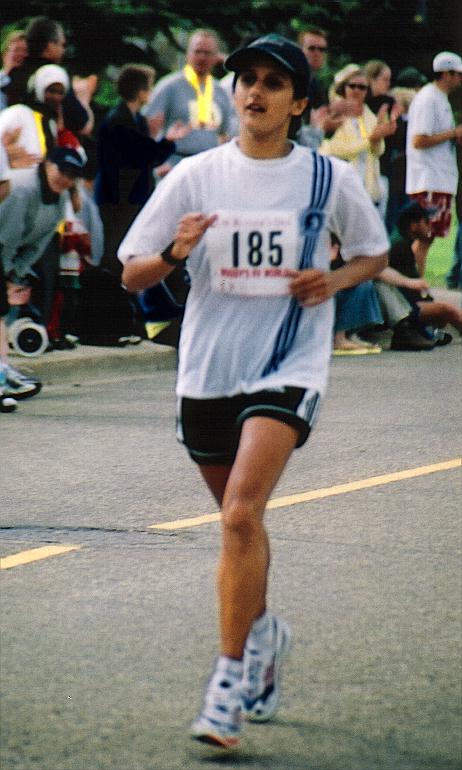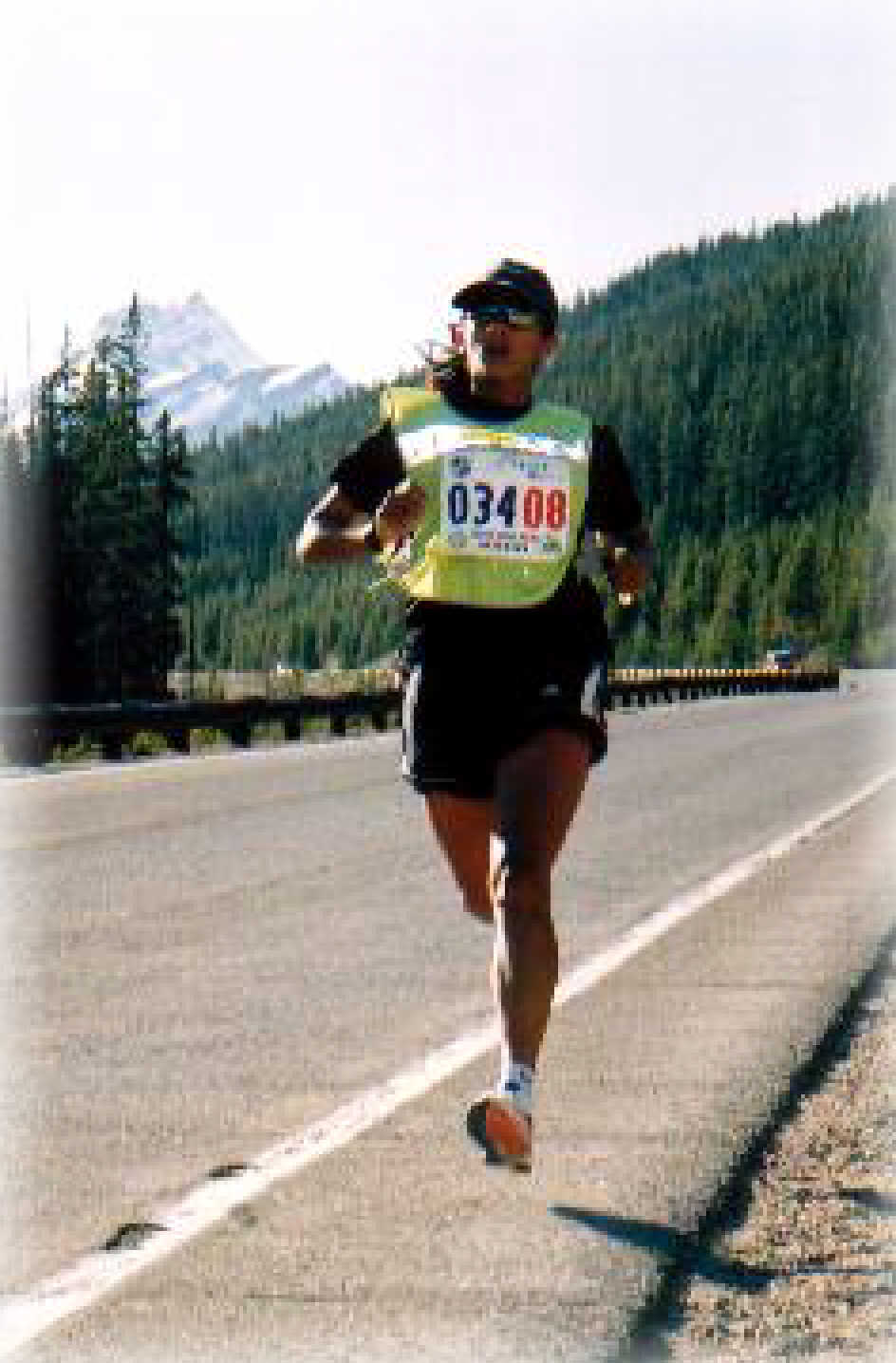Women
in Motion
January 2001
Newsletter

enhancing female performance
Vol 2. Issue 5
January 2001
WOMEN
IN MOTION NEWSLETTER - January 2001
Vol. 2, No. 5
This Month Contains:
~Articles
~From
Around the 'Net
1. Getting That Adequate Fuel for Running
2. Slowing Down
Aging
3. Does Jet Lag
Affect Performance?
4. Hill Walking
5.
Reducing the Risk
of Stroke
~Words
of Inspiration
~The Running Woman Board
-The
Runner's Club
Survey Results
Women in Motion November Survey: What Shoes Do You Run In?
Nike (3) 27%
adidas (3) 27%
Reebok (1) 9%
Asics (1) 9%
Brooks 0%
Mizuno (1) 9%
Other (2) 18%
Thanks for taking the time to complete the survey
Visit the site to see the January - February survey and it's weekly results.
Chondromalacia
What is it?
This is a softening or wearing away and cracking of the cartilage under the kneecap, resulting in pain and inflammation. What happens is that the cartilage becomes like sandpaper because the kneecap is not riding smoothly over the knee.
What Are the Symptoms?:
Pain beneath or on the sides of the kneecap. "It's a soreness, a nagging discomfort," says Dave Apple, M.D., an orthopedic surgeon at Atlanta's Piedmont Hospital. Pain can worsen over a year or so and is most severe after you run hills. Swelling is also present. In severe cases, you can feel--and eventually hear--grinding as the rough cartilage rubs against cartilage when the knee is flexed
What Are the Causes?
Excessive pronation (when the arch collapses too much and the foot rotates too far inward) can cause the kneecap to twist sideways. Fatigued or weak quadriceps muscles, which aid in proper tracking of the kneecap, can prevent the kneecap from tracking smoothly. A muscle imbalance between weak quads and tighter hamstrings can also pull the kneecap out of its groove. Hill running (especially downhills) can aggravate the condition, as can running on the same side of a cambered road, or, in general, overtraining.
What Should You Do?
You should stop running. Try icing the knee for two or three times a day. The frozen gel pack or a bag of frozen vegetables works well. Taking aspirin three times a day can help as Aspirin has been found to block breakdown of cartilage. Massage the sore spots around the knee. Once pain and swelling are gone, you should strengthen quadriceps by doing what is called, step-downs.
Stand on a step or book that is 10 centermetres high. Keep right quadriceps tight and lower the left leg slowly toward the floor. Then raise it back up and relax. Repeat 30 times with each leg. Increase repetitions in groups of five after 2 days. Stop at 50 times.
Also stretch quadriceps and hamstrings. You also might also try wearing a rubber sleeve with a hole that fits over the kneecap.
You should be back to easy running in a month and a half.
Alternative exercises are swimming, deep water running, rowing.
Now What to Do?
Stretch quadriceps, hamstrings and calves.
If you are an over-pronator switch to motion-control shoes with firmer midsoles
Never run in worn-out shoes.
Consider orthotics.
Avoid running downhill, and stay off uneven roads
If chondromalacia isn't responding after four weeks, see an orthopedic surgeon.
Women in Motion January 2001
From Around the 'Net
enhancing female performance
![]()






1. Getting That Adequate Fuel for Running
Optimum utilization of the energy systems for training assumes that you ( the runner) are getting an adequate fuel supply. Getting that adequate nutrition during hard training can be a real challenge for athletes. Many runners have a tendency to underfuel themselves especially those worrying about weight control. Underfueling can lead to sluggishness, fatigue, poor performance, injury and even permanent alteration (lowering) of basal metabolism. If you are having problems getting adequate nutrition, it may be helpful to visit a sports dietician or nutritionist to get a dietary plan that works for you.
You can estimate your daily caloric requirements by knowing your BMR ( basal metabolic rate or the calories needed by your body for basic existence) plus the calories burned by your training and other activities during the day. You can estimate your BMR calories by multiplying your body weight by 10. For example a 150 lb person would have an estimated BMR of 1500 calories. Typical daily activity adds somewhere between 300 and 1000 calories per day. If you have a desk job and are fairly sedentary, add 300 calories; add up to 1,000 calories if your job demands physical labor and you're on your feet all day. Each mile of running consumes about 100 calories. Caloric needs per mile are determined by your body weight rather than by how fast you run. The 150 lb athlete with a desk job who averages 10 miles of running per day burns approximately 3000 calories. The food that the athlete eats provides that energy and replaces the calories burned.
2. Slowing Down Aging
A few fundamentals can keep you running strong as decades
pass
Aging is never easy, of course, but it's possible to make
the years pass gracefully and maintain youth in running
as well as life. While it's true that aging inevitably
brings slower race times, there are a few core training
principles that will keep performance losses minimal and
your legs feeling strong.
Here are some tips for masters runners. The tips can be
broken down to four key practices: stretching, massage,
ice and sleep. These activities fall somewhat into the
category of common sense, but they're also easily
overlooked, particularly among younger runners. Starting
these practices early in your running career will also
allow you to extend that career later into life.
3. Does Jet Lag Affect Performance?
Anyone who has traveled between time zones can tell you that air travel can wreak havoc with your internal clock and dramatically decrease your energy level.
The body has mechanisms in the brain (called "neurons") that help time many biologic and physiologic processes. These neurons are located in the hypothalamic region of the brain, and help to regulate hunger, sleep, temperature and other timing mechanisms, such as circadian rhythms. This internal system has difficulty making rapid adjustments, such as skipping ahead 14 hours, that might occur with long distance travel. When this timing is disrupted, we experience the symptoms of jet lag. Generally, the effects of jet lag are worse when traveling from west to east.
4.
Hill Walking
Once you have reached a level of conditioning where you
can comfortably walk for 20 minutes at your target heart
rate, you may want to add hill walking. Hill walking is a
vigorous form of walking. It uses slightly different
muscles and burns more calories. It is an important part
of an overall walking program.
Hill walking should be tackled at the beginning of your
walk. You will have more energy and not become too
fatigued. Hill walking can cause pain in the calf muscle
from overloading the muscle. To prevent this muscle
strain, include calf stretching exercises in your warm-up
and cool-down. Also, look for walking shoes that have
sturdy heel counters.
5.
Reducing the Risk
of Stroke
Research indicates that good exercise habits during
middle age will reduce the risk of stroke in the
retirement years. In fact, the earlier in your life you
start to exercise, the more protection you accumulate
against stroke. Adults who start aerobic activities such
as running, swimming, and cycling between the ages of 15
and 25 have a 67 percent lower risk for a stroke than
adults who have never exercised.
Also, studies have found that people who burn 2,000-3,000
calories a week in aerobic activity reduce their risk by
46 percent compared to those who get no activity. To burn
2,000 calories a week, a person would need to walk
briskly for 60 minutes, five days a week. In addition,
other risk factors are diminished by physical activity,
such as body fat, cholesterol levels, and heart attacks.
Words
of Inspiration
Never discourage anyone who continually makes progress, The
Running Woman Message Board in Diet and Fitness
The Running Woman Message board continues to be active
although it shows a reduction in the number of posts since
September. Because a number of our members are university
and college students, this time of the year finds them
back at studies. Let's hope they remember the benefits of
running and return soon to our board.. We continue to
offer advise to all posts. Thanks to all of you who have
provided assistance to members old and new. Good Luck and
Continued Running to all. The RUNNER'S CLUB is still quiet, but with the number of
members just over 590. If you are a member, please take
the time to ensure that your email address is the one you
want to use. Members with incorrect email address will be
deleted from the membership as we are unable to contact
them with club information. The last email sent did return 180 undeliverable messages back to my mailbox. Members
have been asked to post on the calendar, their upcoming
race events for the year. About
This Newsletter Practice
doesn't make perfect, perfect practice makes perfect. 
Fariyal Samson Crosses the Finish
at the 2000 Honolulu Marathon
as the 19th Female Overall and the First Canadian Female
no matter how slow.
- Plato
Gord
A continual reminder that two features of the CLUB are the
ability of members to communicate with each other
privately in the CLUB and the ability to arrange to chat
with each other in the 24 hour chat facility.
Good Luck and Great Runs
Gord
A reminder that experts - we are not. Information
presented here is a collection of research with a taste
of experience and opinion added for flavour. We don't get
upset if someone disagrees with anything that has been
said or written. In our experience with running groups
here at home, it is difficult to get agreement on most
anything. If it works for you, then it works.
Neither Women in Motion nor the author of this newsletter
provides professional medical advice. The information in
this newsletter is intended to help you better understand
running issues. It is not intended to replace the advice
of a physician. If you read something in the newsletter
that contradicts what your physician tells you in any
way, always follow your physician's advice.
SUBSCRIBE/UNSUBSCRIBE INFO
You are receiving access to this newsletter because you
have subscribed via Listbot. If you do not wish to have
future newletters sent to you, please use that same
system found on the home page to unsubscribe.
If you have any suggestions for topics or questions
please email us. We would like to publish a monthly
newsletter that reflects the interests of the female
runner.
Gordon Samson, Editor
Women in Motion
LEGAL STUFF / SUBSCRIPTION INFO.
"Women in Motion Newsletter" is free, but its
articles are
copyrighted. No one may use the content without
permission of
the author and "Women in Motion". So please let
us know if you
think the information here is important enough to be
re-written.
Spread the Word
Tell your friends they can get the email link to this
free monthly newsletter.
Gordon and Fariyal Samson
Women in Motion
Visit us at
run.to/womeninmotion
-Fariyal Samson, B.PE, B.Ed
© Women in Motion
![]() Women in Motion January 2001
Women in Motion January 2001